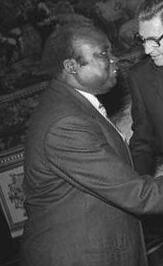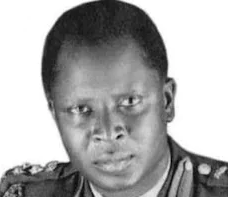
Idi Amin Dada Oumee was a Ugandan military officer and politician who served as the third president of Uganda from 1971 to 1979. He ruled as a military dictator and is considered one of the most brutal despots in modern world history.

The history of Uganda from 1963 through 1971 comprises the history of Uganda from Ugandan independence from the United Kingdom to the rise of the dictator Idi Amin.

Sir Edward Frederick William David Walugembe Mutebi Luwangula Mutesa II was Kabaka, or king, of the Kingdom of Buganda in Uganda from 22 November 1939 until his death. He was the 35th Kabaka of Buganda and the first president of Uganda from 1962 to 1966, when he was overthrown by Milton Obote. The foreign press often referred to him as King Freddie, a name rarely used in Uganda. An ardent defender of Buganda's interests, especially its traditional autonomy, he often threatened to make the kingdom independent both before and after Uganda's independence to preserve it. These firm convictions also later led to conflicts with his erstwhile political ally Milton Obote, who would eventually overthrow him.
The Front for National Salvation (FRONASA) was a Ugandan rebel group led by Yoweri Museveni. The group factually emerged in 1971, although it was formally founded in 1973. FRONASA, along with other militant groups such as Kikosi Maalum, formed the Uganda National Liberation Front (UNLF) and its military wing the Uganda National Liberation Army (UNLA) in 1979 to fight alongside Tanzanian forces against Idi Amin.

Benedicto Kagimu Mugumba Kiwanuka was the first prime minister of Uganda, a leader of the Democratic Party, and one of the persons that led the country in the transition between colonial British rule and independence. He was murdered by Idi Amin's regime in 1972.
Busoga College Mwiri, commonly known as Busoga College, is a boarding secondary school located in the eastern region of Uganda, specifically Jinja.
Kikosi Maalum, also known as the Special Battalion or the grand coalition, was a militia of Ugandan exiles formed in Tanzania to fight against the regime of Idi Amin. The unit was founded by and loyal to former Ugandan President Milton Obote, and served as his de facto private army. It was commanded by former army officers David Oyite-Ojok, and Tito Okello. Kikosi Maalum took part in the Uganda–Tanzania War, fighting alongside the Tanzanian military against Amin's forces. In course of this conflict, the militia was nominally unified with other Ugandan rebel groups, forming the Uganda National Liberation Army (UNLA) in 1979. After the fall of Amin's regime and Obote's return to power, Kikosi Maalum became the core of Uganda's new national army.
Makindye Prison is a Uganda government state-run prison which became notorious for extrajudicial killings and execution of government opponents during the time of Ugandan dictator, Idi Amin.

In Uganda, the Leader of the Opposition (LOP) is the leader of the largest political party in the Parliament of Uganda that is not in government. The Leader of the Opposition appoints and heads an alternative shadow cabinet whose duty it is to challenge and influence governmental actions and legislation on the floor of Parliament.

Basil Kiiza Bataringaya was a prominent Ugandan politician in post-independence Uganda. He was the Leader of the Opposition at the beginning of the Apollo Milton Obote government, and then he changed parties and was appointed to the powerful role of Ugandan Minister of Internal Affairs. He was imprisoned, tortured, and was one of the first political prisoners to be executed by the Idi Amin regime.
Juma Ali Oka Rokoni, commonly referred to as Juma Butabika, was a Ugandan military officer who served as Uganda Army (UA) top commander during the dictatorship of Idi Amin. Despite being notorious for his erratic behavior and abuse of power, he was highly influential, held important army commands, and served as long-time chairman of the Ugandan Military Tribunal, a military court used by Amin to try and eliminate political dissidents and rivals. By commanding an unauthorised attack on Tanzania in October 1978, Butabika was responsible for the outbreak of the Uganda–Tanzania War which ultimately resulted in his death in combat, probably during or shortly before the Fall of Kampala.

Ernest Obitre Gama is a Ugandan former military officer and diplomat. He was the first military officer in Uganda to become a diplomat, and was appointed Minister of Internal Affairs by Idi Amin. He later was the Ugandan ambassador to Japan, Italy, and Sudan under Yoweri Museveni.
Cuthbert Joseph Obwangor was a longtime Ugandan minister and legislator. He was a minister and a political prisoner for the Apollo Milton Obote regime after he opposed Obote's extension of power while Obwangor was a minister.
Godfrey Serunkuma Lule is a Ugandan lawyer. He was Minister of Justice and Constitutional Affairs of Uganda for Idi Amin and defected, becoming a prominent international critic of Amin. He went on to found the prominent Ugandan Law and Consulting firm Sebalu & Lule Advocates and Legal Consultants.

Ali Fadhul was a Ugandan military officer and convicted criminal who served as governor, minister and army chief of staff during the dictatorship of President Idi Amin. In course of his career, he also commanded the Simba Battalion of the Uganda Army (UA). He was one of Amin's last loyal followers during the Uganda–Tanzania War of 1978–1979. Following the conflict, Fadhul was arrested by the new Ugandan government, and convicted of murder. Sentenced to death, he spent 22 years in prison until he was pardoned by President Yoweri Museveni in 2009.

The 1972 invasion of Uganda was an armed attempt by Ugandan insurgents, supported by Tanzania, to overthrow the regime of Idi Amin. Under the orders of former Ugandan President Milton Obote, insurgents launched an invasion of southern Uganda with limited Tanzanian support in September 1972. The rebel force mostly consisted of the "People's Army" whose forces were mainly loyal to Obote, but also included guerillas led by Yoweri Museveni. The operation was hampered by problems from the start, as a planned rebel commando raid had to be aborted, Amin was warned of the impending invasion, and the rebels lacked numbers, training, and equipment. Regardless, the militants occupied a few towns in southern Uganda at the invasion's start. However, no major popular uprising erupted as Obote had hoped.

John Babiiha was a Ugandan politician, rancher and farmer. He was Uganda's first Republican Vice President under the Uganda People's Congress which was led by Apollo Milton Obote. He also served as the Minister of Animal Resources under Milton Obote. He is believed to have founded the Uganda People's Congress Party in 1959 with Obote, Sam Odaka and Felix Rwambarari.
Tereza Mbire is a Ugandan entrepreneur, presidential advisor and advocate. She is a co-founder of the Uganda Women's Finance and Credit Trust and founder of the Uganda Women Entrepreneurs' Association Ltd.
Yorokamu Tizihwayo, also known as Y. Tiziriwayho and Yerukamu, was a Ugandan military officer. He served as a high-ranking commander during Idi Amin's rule as Ugandan President, first as the head of the 2nd Paratrooper Battalion and later for the Western Brigade. In the Uganda–Tanzania War (1978–1979), Tizihwayo led the Uganda Army troops which opposed the Tanzania People's Defence Force's advance into western Uganda. Despite being regarded as a talented soldier and considered one of the Tanzanians' more dangerous opponents during the war, he was eventually arrested and executed on alleged treason charges by Amin's State Research Bureau.










